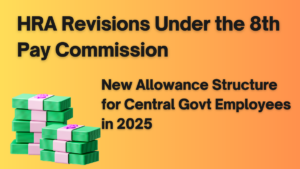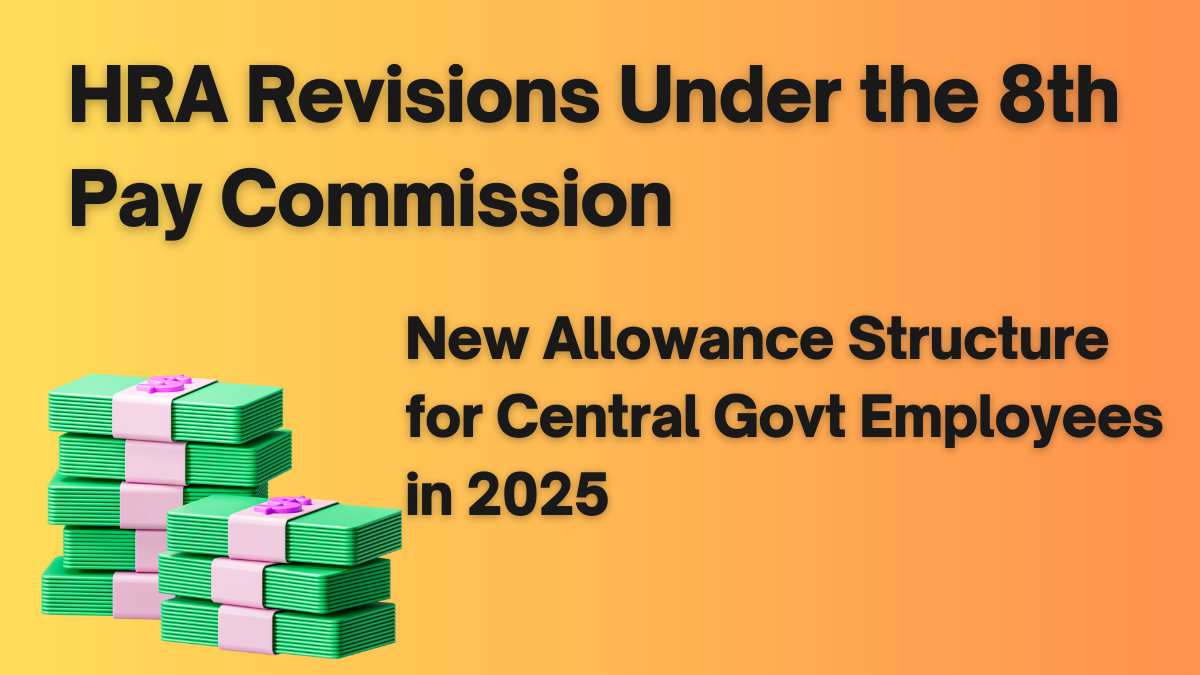The House Rent Allowance (HRA) is a critical part of the salary package for central government employees in India. With the government contemplating the 8th Pay Commission and the increasing cost of living in urban cities, employees are curious about how the allowance will be revised. In this article, we explore the expected updates to HRA under the 8th Pay Commission, specifically the percentage of HRA applicable to employees in different city categories (X, Y, Z) based on the guidelines under the 7th Pay Commission.

Understanding House Rent Allowance (HRA)
HRA is an important component of the salary structure that helps government employees meet their housing costs. The amount of HRA depends on the employee’s city of posting, their pay scale, and other factors. As of the 7th Pay Commission, the percentage of HRA granted is divided into three categories of cities based on their cost of living:
- X Cities: These are the most expensive cities in India, including metros like Delhi, Mumbai, Chennai, and Kolkata. Central government employees posted in these cities receive the highest percentage of HRA.
- Y Cities: These cities have a moderate cost of living. Examples include cities like Bangalore, Pune, and Hyderabad.
- Z Cities: These cities have the lowest cost of living. Smaller cities and towns fall into this category.
The percentage of HRA given to employees in each category is calculated based on their basic pay and the location of their workplace.
HRA Percentage Under the 7th Pay Commission
The 7th Pay Commission had outlined specific HRA percentages for central government employees based on the categorization of cities. The percentages were as follows:
- X Cities: 24% of the basic pay
- Y Cities: 16% of the basic pay
- Z Cities: 8% of the basic pay
These percentages were intended to help employees cover housing costs and were revised according to the cost of living in each city. However, with the 8th Pay Commission on the horizon, employees are eager to know how these figures will change.
Expected Changes to HRA in the 8th Pay Commission
While the 8th Pay Commission is still in the process of being finalized, there are a few key expectations regarding changes to HRA under the new guidelines. Based on current trends and the rising cost of living, it is likely that the HRA structure will see a revision in both the percentage and the categories of cities.
1. Increase in HRA Percentages
The government may consider increasing the percentage of HRA to match inflation and the rising costs of living in major cities. Employees in X Cities may see an increase to 30% or more, while employees in Y Cities could expect a hike to around 20%. Employees in Z Cities may also see a marginal increase.
2. Revised City Classification
The 8th Pay Commission may introduce a new classification system for cities. Currently, the 7th Pay Commission divides cities into three categories, but the growing urbanization and rapid economic changes may lead to the introduction of new classifications. For example, the government may create sub-categories under the existing X, Y, and Z classifications, accounting for varying living standards in different parts of a city.
3. Dynamic Revisions Based on Cost of Living
The 8th Pay Commission could introduce a more dynamic and flexible system for calculating HRA, based on annual or semi-annual revisions of the cost of living in major cities. This would make the HRA amount more responsive to economic changes, ensuring that employees’ housing needs are addressed in real-time.
4. Digitalization and Transparency in HRA Calculation
One of the expected changes in the 8th Pay Commission is the move toward digital platforms for calculating and distributing HRA. This would provide employees with transparent access to their housing allowances and allow them to track any changes more efficiently.
The Impact of HRA on Central Govt Employees
The HRA is one of the most critical allowances for central government employees, particularly for those posted in urban areas. The increasing cost of living, especially in metropolitan cities, has made HRA a vital part of the salary structure. For employees, an increase in HRA would mean relief in managing rising housing costs. However, any changes to the HRA percentages will be closely watched, especially as the economy continues to adjust to new challenges.
Conclusion
The 8th Pay Commission is set to bring significant changes to the way central government employees are compensated, particularly regarding allowances like HRA. With rising living costs, especially in major cities, it is expected that the government will revise the HRA percentages and possibly the classification of cities. As we await further updates, employees should keep an eye on the official announcements regarding these changes to better plan their finances.
People May Ask
1. Will the 8th Pay Commission increase HRA percentages for employees in urban cities?
It is likely that the HRA percentages will be increased under the 8th Pay Commission, particularly for employees posted in cities with a high cost of living.
2. How is the HRA amount calculated?
The HRA is calculated as a percentage of the employee’s basic pay. The percentage depends on the city’s classification under the 7th or 8th Pay Commission guidelines.
3. Will there be new classifications for cities under the 8th Pay Commission?
There is speculation that the 8th Pay Commission may introduce new city classifications or sub-categories to better address the varying costs of living in different regions.
4. When will the 8th Pay Commission HRA revisions be implemented?
The exact date for the implementation of the 8th Pay Commission revisions is still to be announced, but it is expected to come into effect in the near future, likely by 2025.
5. How can central government employees stay updated on the HRA changes?
Employees can stay informed by regularly checking government notifications, official websites, and trusted news sources for updates on the 8th Pay Commission’s recommendations.
Pari is a passionate writer known for captivating stories that blend imagination and reality. Inspired by travel, history, and everyday moments, Pari crafts narratives that resonate deeply with readers.

